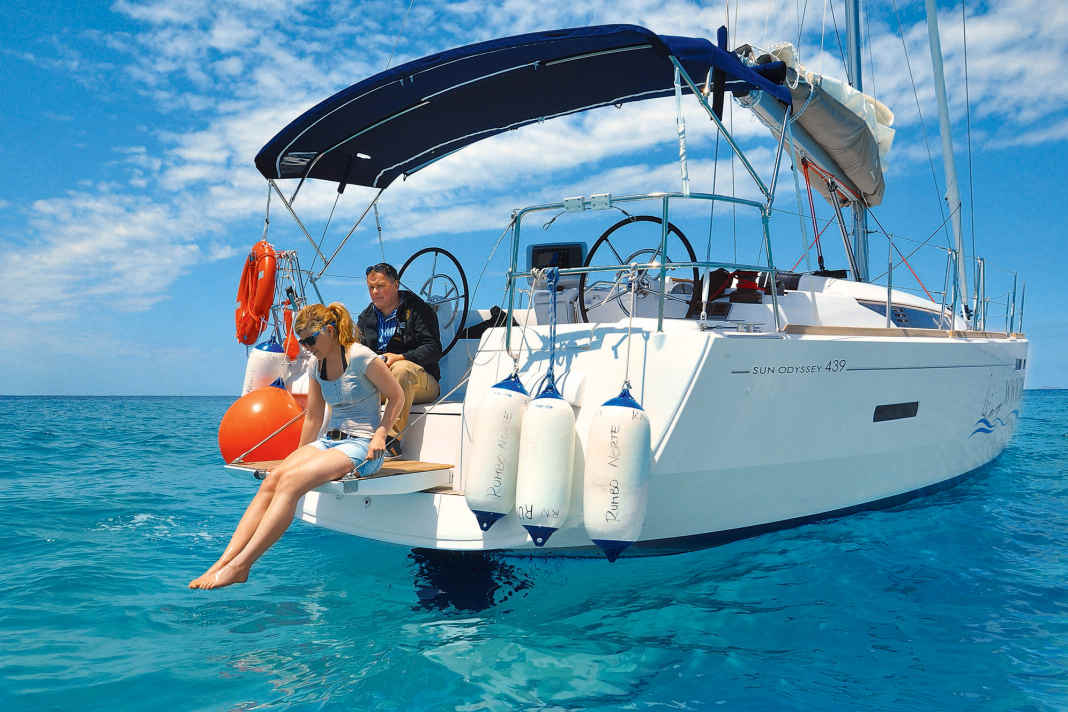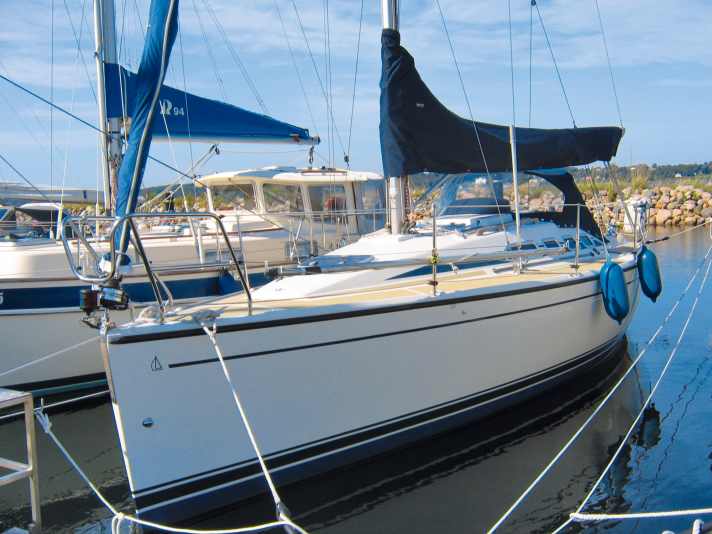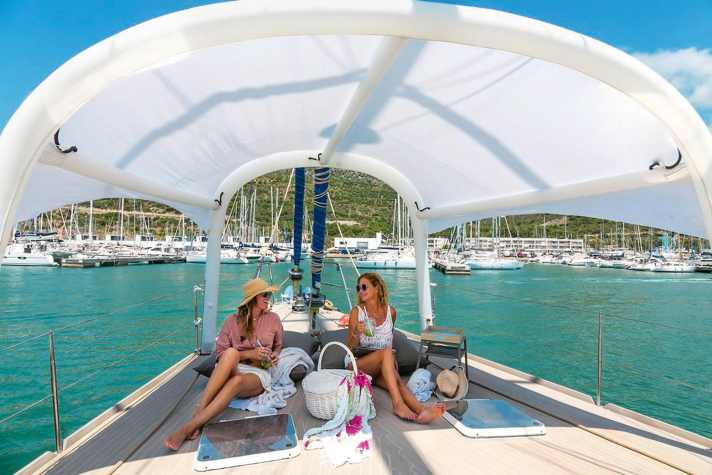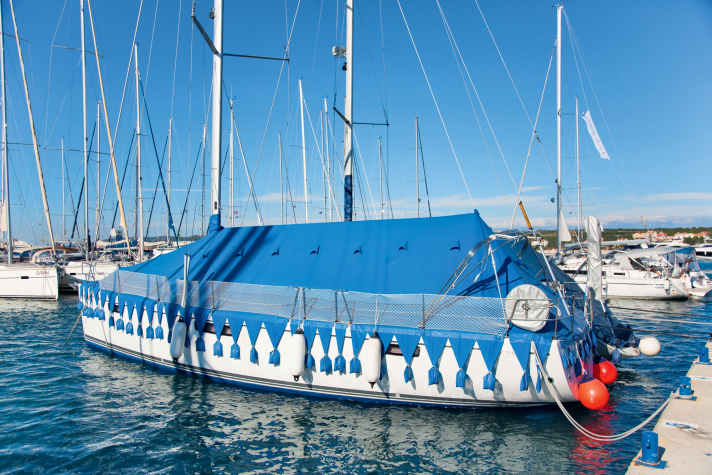





Even in northern latitudes, UV radiation is getting stronger and stronger. Experts estimate an annual increase of around one per cent. This may sound low, but it does have noticeable consequences, including for yachts, dinghies and their equipment: plastics become brittle, paintwork weathers and fabrics age more quickly. Ten per cent more radiation per decade means: On sunny summer days, the exposure in northern Europe is now comparable to that previously experienced in the Mediterranean region. Owners there know the consequences of UV radiation. Tarpaulins, sheets, wooden parts, gelcoat and even inflatable boats lose colour, shine and strength.
Accordingly, light protection is also becoming increasingly important. This starts with the sails. UV rays attack the fabric and cause it to age more quickly. It doesn't matter whether it's a Dacron or laminate sail. The materials lose their breaking strength, plasticisers and coatings and lose their shape. At the end of the day, a new wardrobe is needed sooner than necessary.
Also interesting:
Dealers such as SVB or Decathlon offer the cheapest off-the-peg tarpaulins for mainsails or headsails. How well these standardised products actually fit is questionable. Only the length of the protection can be selected, not the circumference. If the sun protection is too large, it will flap in the wind; if it is too small, it will not be effective enough or cannot be fitted at all.
Protection for your expensive wardrobe

This can hardly happen with a customised tarpaulin. They are often a little more expensive, but the investment is usually worth it. As an example, we have chosen a Dehler 34 and an X-79. The Dehler has a forestay length of 13.29 metres, while the X-79 has a length of nine metres.
The Dehler has a boom length of 4.95 metres, the X-79 3.50 metres. The prices for the cloths of the two boats are correspondingly different. SVB no longer offers a suitable boom cover for the Dehler. The maximum length here is 4.75 metres. As the sail does not usually reach to the end of the boom, we will still use it as a reference. The favourable version would cost 295 euros for the Dehler and 248 euros for the small X. Decathlon only has three sizes in its programme. These fit neither the X-Yacht nor the Dehler. They would have to be reworked, an effort that is hardly worthwhile in view of the high labour costs.
As a comparison, we asked the Kiel-based canopy specialist Segelmacherei Molkentin to provide us with representative quotes for both tarpaulins. There, the customised boom cover for the Dehler would cost around 520 euros and around 415 euros for the X-79. The length and circumference are accurate to the millimetre. Special requests such as names, sail marks and colours or different materials are also no problem. On request, the boom cover can also be designed as a lazy bag.
Many roller sails already have a sewn-in UV protection strip
The situation is similar with the foresail cover. Many furling sails already have a sewn-in UV protection strip, but this alone is hardly sufficient in the long term and does not protect the fabric from soiling. A tarpaulin is the better solution.
The canvas cover for the Dehler costs 570 euros from SVB. However, the tarpaulin is then a little too long and has to be shortened. For the X-79 it is still 326 euros. At least the length would fit well. The circumference of both models can be reduced with a line. This avoids annoying flapping, which in the worst case can lead to damage to the rig.
Kieler Segelmacherei would charge 757 euros for the Dehler and 495 euros for the X-Yacht. Company boss Nils Molkentin advises: "If the sails have no UV protection, the boom and furling jib cover should be used as soon as possible as soon as you are back in harbour. Every UV hour damages the sail." If you want a customised boom cover or lazy bag, the best place to go is your local sailmaker. The tarpaulin measured by a professional will fit or be made to fit.
How the crew can protect themselves from the sun

People also need protection. This is provided by awnings in the harbour. Underway, elaborate models provide shade. While most awnings can only be installed when the mainsail is retracted, there are individual products that can remain up while sailing and then sometimes look more or less like an umbrella.
But a small deduction in the style score is certainly better than a heat stroke or sunburn. Simple umbrellas on a yacht have obvious advantages: they don't need to be guyed when it's calm, they can be positioned in the direction of the sun and the costs are manageable.
One example is the free-hanging sunshade from Watski, which is available from Compass and others. It is something between a parasol and a sun canopy and can be hung under the large tree or on the large drop. The sunshade is available in three different sizes. At just under 70 euros for the 1.45 x 1.45 metre version, it is one of the cheaper products.
Alternatively, a standard parasol can of course also be used. Special mounting aids are available for this purpose, which can be attached to the pushpit or winch. They are fixed with a clamping mechanism and have an opening for the sunshade pole. The latter is particularly recommended for boats without railings. To be able to set up the sunshade, the tip of the lower telescopic pole must be removed, which otherwise makes it easier to drill into the sand.
Tent roofs and awnings to protect against UV radiation
Large tent roofs with spreader poles are more effective than sunshades and do not require any additional poles. Without the interfering poles, there is more space and the structures are airier than the free-floating solutions that have to be tensioned downwards to the railing.
The Sunsave from the Zengerle yachting agency is one of those sun canopies that can remain tensioned while sailing. The roof fits snugly around the split backstay and is closed with sewn-in zips. It is tensioned with clamcleats, the tension of the elliptical shape prevents chill, so that the sun protection can remain in place even in slightly stronger winds. As an option, side covers can be attached as protection when the sun is low in the sky.
It is also possible to stretch awnings over the main boom. Suitable cloths are available from Oleu, for example. More specialised products such as the overhead in the form of a giant frisbee or the inflatable cover tent also offer good solutions. In both cases, several loops need to be used to tension the tent downwards.
The deck tent consists of a Dacron outer skin, a heat protection layer made of PE and a TPU tube. It requires neither a bimini pole nor special brackets. The deck tent is available in sizes XS, S, M and L. XS and S are supplied with four tensioning straps, while M and L are equipped with two height-adjustable straps per leg. The tent is designed to withstand wind speeds of up to 20 knots.
Fixed and self-supporting sun shading
The market also offers various self-supporting solutions. Seaeq's triangular awning was developed entirely for use on board, so there are no metal parts that could rust, chafe or flap in the wind. The triangular shape can be fitted either as vertical stern protection or horizontally over the foredeck. The J-measurement from the mast to the forestay attachment must be at least three metres. The model is watertight.
In addition to a conventional fixed bimini, a cake stand is of course also suitable as sun protection. These can be customised to the respective boat by your trusted sailmaker and therefore fit perfectly. There are no limits to the ideas: With windows in the roof, you can even leave them up while sailing if they are out of the way of the boom and still be able to see into the main. Ventilation with fly screens can be realised, as can darkening and opening side panels - many things are possible, depending on your wishes. Tip: If you have a zip attached to the sprayhood, you can attach the cake stand to it without any problems or gaps.
The biminis familiar from motorboats and sailing yachts in the Mediterranean are also becoming increasingly popular with sailors in the north. They should also be customised by the tarpaulin maker or sailmaker.
Full tarpaulin as a complete solution

Rig and crew can thus be well protected. Covers for wheels are also useful, especially those made of carbon fibre or GRP. Instruments also become brittle more slowly with covers. Or you can protect the entire deck. Full tarpaulins are particularly popular for smaller wooden boats. They cover the entire boat and protect it completely from rain, sunlight and dust or sand in the air. There are almost no limits here either. Window segments that can be rolled up or completely removable with zips - the possibilities are endless. In any case, the deck also benefits from this, whether teak or plastic. Wooden decks have their own rules anyway. Although an unpainted, dry and dirt-free wooden deck will turn grey, it cannot be destroyed by sunlight. But it can discolour.
It becomes more complicated if the wood has been treated with varnishes, oils or resins. The sun can then unleash destructive forces, causing varnishes to peel off and epoxies to yellow. Therefore, if you have large wooden areas on board, you can save yourself a lot of maintenance work by covering these areas with a tarpaulin. Nils Molkentin advises using light-coloured fabrics for a full tarpaulin. According to the cover expert, the heat build-up is many times higher with dark-coloured fabrics.
Over time, plastics lose their plasticisers due to UV radiation and become brittle. This can cause the handles of the lever clamps to break or a block to lose its pane. Boat windows, which are usually made of acrylic glass, suffer a similar fate. This plastic also becomes brittle over time and forms hairline cracks or becomes brittle. Covers are available to prevent this. They are attached to the outside of the window with press studs or rubber bands and thus protect against the sun. And if you want to block out the sun like at home, you can use roller blinds.

